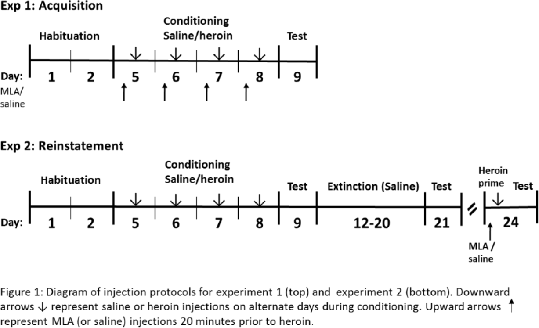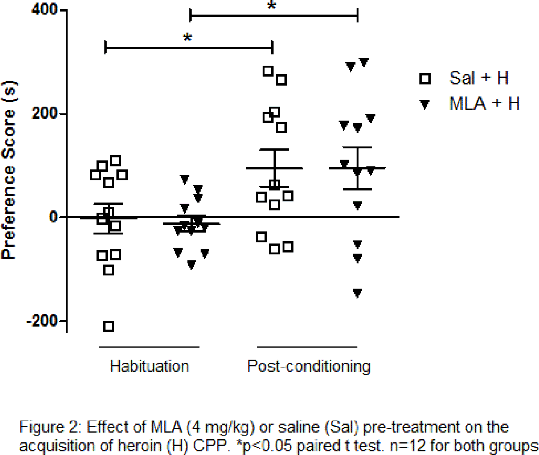| 143P London, UK Pharmacology 2017 |
Investigating the role of alpha7 nicotinic acetylcholine receptors in opiate relapse
Introduction: Opiate addiction is a major health and economic burden to society, exacerbated by the high risk of relapse. Drug addicts form associative memories in the context of drug use, which trigger cravings and prompt relapse (1). Preventing relapse is a major goal and we and others have shown that methyllycaconitine (MLA), an α7-nicotinic acetylcholine receptor (α7nAChR) antagonist attenuates the reinstatement of morphine-primed conditioned place preference (CPP) in rodents (2, 3). The aim of this study is to investigate the effects of MLA on CPP with a more clinically relevant opiate, heroin.
Method: All rats (male, Wistar, 6-7 weeks) underwent heroin CPP (1 injection daily over 4 days, alternating between saline and heroin (1mg/kg)) (4). Experiment 1 (Acquisition): rats were pretreated with either saline or MLA (4mg/kg) 20 minutes prior to each conditioning injection. Preference was recorded the following day (15 minutes free-roaming). Experiment 2 (Reinstatement): rats were conditioned with heroin then underwent extinction (1 saline injection daily prior to placement in heroin- or saline-paired chamber, alternately over 9 days). Rats were then assigned a reinstatement treatment group and received either saline or MLA (4mg/kg) 20 minutes prior to heroin-priming (1mg/kg) or saline. All injections were s.c.. Treatments were assigned randomly and pairing was counterbalanced. Rats were tracked with Noldus Ethovision software. Preference testing sessions were 15 minutes. Conditioning sessions were 40 minutes. Data shown as mean±SEM. Statistics: Exp1: paired t test; Exp2: one-way ANOVA with Bonferroni post hoc.

Results:

Conclusions: MLA has no effect on the acquisition of heroin CPP, suggesting it has no effect on the rewarding properties of heroin. MLA however significantly blocks the reinstatement of heroin-primed CPP, suggesting a selective role for α7nAChRs in relapse. The ability to pharmacologically distinguish between the different stages of addiction is exciting for potential therapies targeted at opiate relapse. Further investigation of the underlying mechanisms will be undertaken to disclose relevant brain mechanisms.
References:
(1) Kauer JA and Malenka RC (2007). Nat Rev Neurosci 8: 844-858
(2) Feng B et al. (2011). Behav Brain Res 220: 100-105
(3) Wright VL etal. (2013). http://www.pA2online.org/abstracts/Vol11Issue3abst030P.pdf
(4) Cordery SF et al. (2014). Addict Biol 19: 575


.gif)